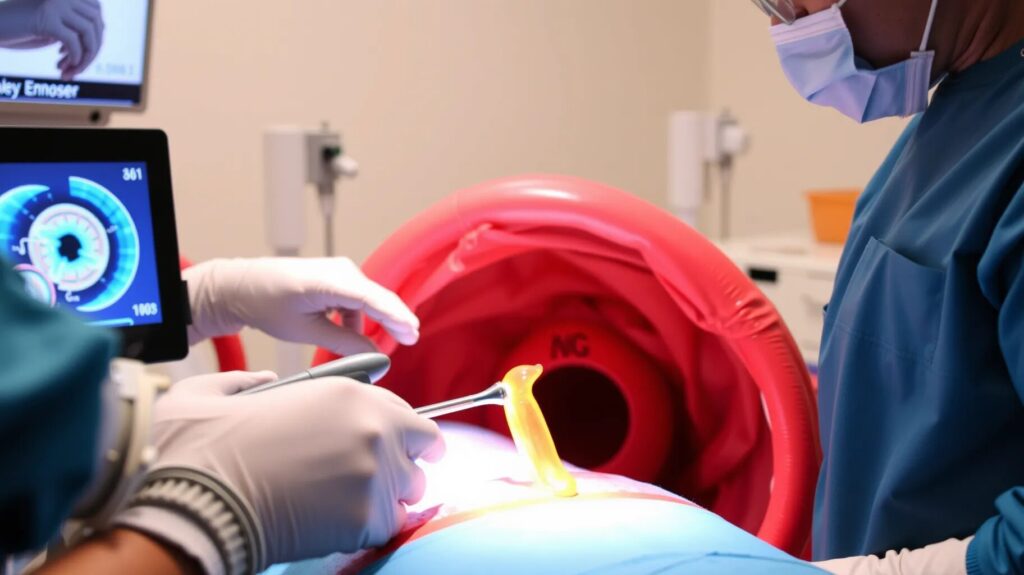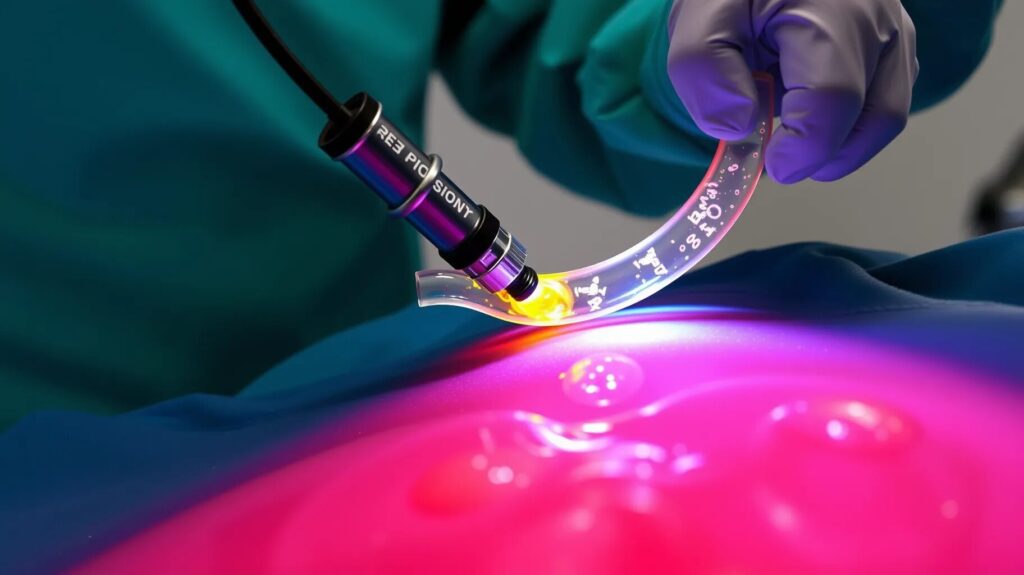
The promise of Robo-Slime in the medical field is captivating, but to fully appreciate its potential, it’s essential to delve deeper into its capabilities and how it stacks up against the traditional tools that have long been the backbone of modern medicine. As we explore the nuances of this innovative technology, we’ll uncover how Robo-Slime could revolutionize various aspects of medical practice, from surgery to diagnostics, and even drug delivery.
The Science Behind Robo-Slime: More than Just a Gooey Substance
At first glance, Robo-Slime might seem like an odd choice for a medical tool. However, this material is far more sophisticated than its name suggests. The core of Robo-Slime’s functionality lies in its composite structure. It’s typically made from a combination of polymers and magnetic particles, giving it the unique ability to be remotely controlled using external magnetic fields.
This smart material can be fine-tuned to exhibit different properties—such as viscosity, elasticity, and responsiveness to magnetic fields—making it incredibly versatile. It can transition from a solid-like state to a fluidic form, allowing it to adapt to various environments within the human body. This dynamic behavior is crucial for tasks that require the material to navigate through tight, complex, or otherwise inaccessible regions.
Precision and Versatility: A New Frontier in Surgery
In surgical applications, precision is paramount. Traditional surgical tools, while effective, have their limitations, particularly when dealing with delicate structures like nerves, blood vessels, or internal organs. Robo-Slime, with its ability to morph and adapt, offers a new level of precision that traditional tools simply cannot achieve.
Navigating Challenging Anatomical Structures
Consider procedures involving the brain or heart, where the slightest misstep could have severe consequences. Traditional surgical instruments, even the most advanced ones, often require fixed pathways and can be difficult to maneuver around sensitive structures. Robo-Slime, however, can glide through these complex anatomical landscapes, reaching areas that might be impossible for rigid tools to access.
For instance, in neurosurgery, where accessing deep brain regions without damaging surrounding tissue is a challenge, Robo-Slime could be directed precisely to the target area, reducing the risk of collateral damage. This level of precision could be revolutionary in treating conditions like brain tumors, where traditional approaches often involve significant risks.
Complex Procedures with Minimal Invasiveness
Beyond precision, the ability to perform minimally invasive procedures is a significant advantage of Robo-Slime. Traditional tools often require larger incisions to navigate through the body or to reach specific organs. Even with advancements in laparoscopic surgery, there are limitations in how minimally invasive these procedures can be.
Robo-Slime can be introduced into the body through a small incision or even via natural orifices. Once inside, it can navigate autonomously or under remote control, performing tasks like cutting, suturing, or delivering targeted therapy with minimal disruption to the surrounding tissue. This not only reduces the trauma associated with surgery but also accelerates recovery times and reduces the risk of post-operative complications.
Diagnostics Reimagined: Beyond What the Eye Can See
Diagnostics is another area where Robo-Slime’s capabilities shine. Traditional diagnostic tools like endoscopes, catheters, and imaging devices are often limited by their size, rigidity, or inability to access certain parts of the body. Robo-Slime offers a radically different approach to diagnostics by being able to physically interact with the environment inside the body.
Navigating Hard-to-Reach Areas
Traditional diagnostic tools can struggle with navigating the complex terrain of the human body. Narrow blood vessels, sinuous intestines, or the branching bronchi in the lungs present challenges that rigid tools cannot easily overcome. Robo-Slime, with its flexible, shape-shifting abilities, can enter these hard-to-reach areas, providing a more comprehensive diagnostic capability.
For example, in gastrointestinal diagnostics, Robo-Slime could be used to navigate the entire digestive tract, capturing detailed images or samples without the discomfort and invasiveness of a traditional endoscope. This could lead to earlier detection of conditions like colorectal cancer, where the ability to thoroughly examine the colon is crucial.
Real-Time, Interactive Diagnostics
Another advantage is the potential for real-time diagnostics. Traditional imaging techniques like MRI or CT scans provide static images or sequences that require interpretation after the fact. Robo-Slime, however, can interact with its environment in real-time. This could enable dynamic assessments, such as monitoring how tissues respond to stimuli or how blood flows through vessels, providing doctors with immediate feedback and more accurate diagnoses.
Advanced Drug Delivery: Targeted and Controlled
The ability to deliver drugs precisely where they’re needed in the body is a game-changer in medicine. Traditional drug delivery methods, such as oral medications or injections, often suffer from systemic side effects because the drug affects the entire body, not just the target area. Robo-Slime offers a more controlled and targeted approach.
Precision in Drug Delivery
Robo-Slime can be loaded with medication and guided to a specific location within the body, where it releases the drug directly at the site of the disease or injury. This targeted delivery reduces the amount of medication needed and minimizes side effects, making treatments more effective and safer.
Imagine a scenario where chemotherapy drugs, instead of affecting the entire body, are delivered only to the tumor site by Robo-Slime. This would significantly reduce the harmful side effects typically associated with chemotherapy, such as nausea, hair loss, and weakened immune function. This precision also opens the door for treating diseases that require localized treatment, such as infections in specific organs or tissues.
Responsive and Controlled Release
Furthermore, Robo-Slime can be engineered to release drugs in response to specific stimuli, such as pH changes, temperature, or even external magnetic fields. This responsive drug delivery system allows for greater control over when and how the medication is released, ensuring that it’s administered at the optimal time for maximum efficacy.
For chronic conditions like diabetes, Robo-Slime could be used to deliver insulin in response to rising blood sugar levels, providing more consistent blood sugar control compared to traditional methods. This could lead to better disease management and improved quality of life for patients.
The Current Landscape of Endoscopy

Before we explore Robo-Slime’s potential, it’s essential to understand the current endoscopy landscape. Traditional endoscopes are crucial for diagnosing and sometimes treating conditions within the gastrointestinal tract, respiratory system, and other internal structures. They provide real-time images and allow doctors to take biopsies or perform minor surgeries without large incisions.
However, these procedures come with limitations:
- Discomfort: Patients often experience discomfort, particularly during colonoscopies or upper endoscopies, where the scope must navigate tight or sensitive areas.
- Limited Access: Certain regions of the body remain difficult to reach with traditional endoscopes, sometimes requiring multiple procedures.
- Invasive Nature: Although endoscopies are minimally invasive compared to surgery, they still involve inserting a foreign object into the body, which carries risks such as bleeding, infection, and, in rare cases, perforation of organs.
Given these challenges, the medical field is ripe for innovation. Enter Robo-Slime, a material that could revolutionize how endoscopies are performed.
What Makes Robo-Slime Different?
Robo-Slime is a soft, flexible, and highly adaptive material that can be controlled remotely using magnetic fields. Unlike traditional endoscopes, which are rigid or semi-rigid, Robo-Slime can morph and move through the body’s narrowest passages with ease. This flexibility opens up new possibilities for endoscopic procedures that are less invasive, more comfortable, and potentially more effective.
Navigating the Unnavigable: Flexibility at Its Finest
One of the most significant advantages of Robo-Slime in endoscopy is its unparalleled flexibility. Traditional endoscopes, though flexible, still have limitations when it comes to navigating complex or convoluted anatomical structures. For instance, in a colonoscopy, the scope must navigate the twists and turns of the colon, which can cause discomfort and make it challenging to reach certain areas.
Robo-Slime, however, can smoothly flow through these tight spaces, reducing the discomfort associated with traditional scopes. Its ability to change shape and viscosity means it can adapt to the body’s contours, potentially reaching areas that traditional endoscopes struggle to access. This could be particularly beneficial for procedures like small bowel endoscopy, where the lengthy and winding nature of the small intestine poses significant challenges.
Enhanced Diagnostics: Seeing What’s Been Missed
Traditional endoscopes are limited by their size and the quality of the camera attached. While advances in camera technology have improved image quality, there are still blind spots—areas that are difficult or impossible to visualize. Robo-Slime could change this by offering a more thorough and detailed examination.
Because Robo-Slime can conform to the shape of the cavity it’s exploring, it has the potential to capture images from angles that traditional endoscopes can’t reach. Imagine a device that could navigate the narrowest of airways in the lungs or the smallest ducts in the liver, providing a full 360-degree view. This level of detail could lead to earlier and more accurate diagnoses, particularly in cases where lesions or abnormalities are hidden from conventional scopes.

Less Invasive, More Comfortable
One of the most significant hurdles in endoscopy is patient comfort. The thought of having a tube inserted into the body can be daunting, and the procedure itself, while usually not painful, can be uncomfortable. Robo-Slime offers a less invasive alternative.
Since Robo-Slime doesn’t require the same level of physical insertion as traditional endoscopes, it could be introduced into the body through smaller openings or even via natural orifices with minimal discomfort. For instance, instead of inserting a long tube through the mouth or rectum, Robo-Slime could be deployed in a compact form and then expanded once inside the body to perform the necessary examination.
This reduction in invasiveness could lead to:
- Lower anxiety for patients.
- Faster procedures with less need for sedation.
- Quicker recovery times and fewer complications post-procedure.
Overcoming the Challenges: Integration and Acceptance
While the potential advantages of Robo-Slime are clear, there are challenges that must be addressed before it can be widely adopted in the medical field.
Biocompatibility and Safety
One of the primary concerns is biocompatibility. Any material used inside the human body must be safe, non-toxic, and non-reactive. Although Robo-Slime is designed with biocompatibility in mind, extensive testing is needed to ensure that it doesn’t trigger immune responses or cause other adverse effects.
Additionally, the long-term effects of having Robo-Slime inside the body, even temporarily, need to be studied. Questions about how it degrades, how it’s removed after use, and what impact it might have on surrounding tissues must be thoroughly explored before it can be considered a viable medical tool.
Technological and Ethical Considerations
There are also technological and ethical considerations. The ability to remotely control Robo-Slime opens up possibilities for its misuse or malfunction. Ensuring that the technology is secure, reliable, and used ethically is paramount. Moreover, integrating Robo-Slime into existing medical practices will require training and adaptation by medical professionals, which could slow its adoption.
The Future: Complementary, Not Competitive
As promising as Robo-Slime is, it’s unlikely to completely replace traditional medical tools. Instead, it will likely serve as a complement to existing methods, enhancing their capabilities and filling in gaps where traditional tools fall short.
For instance, while Robo-Slime might excel in navigating tight spaces or delivering drugs with precision, traditional tools may still be preferred for more straightforward procedures or where rigid control is necessary. The key will be integrating Robo-Slime into the broader toolkit available to doctors, allowing them to choose the best tool for each specific situation.
Conclusion: A Slimy Leap Forward in Medicine
Robo-Slime represents a significant leap forward in medical technology, offering a unique combination of flexibility, precision, and versatility that traditional tools can’t match. While there are challenges to overcome, the potential benefits—ranging from minimally invasive surgery to advanced diagnostics and targeted drug delivery—make it an exciting development in the field of medicine.
As research continues and this technology evolves, we may find that Robo-Slime doesn’t just complement traditional medical tools; it could redefine what’s possible in medical care. The future of medicine might indeed be a little slimy, but in the best possible way.
Journal References
- Li, J., Zhan, Z., & Yang, J. (2022). Magnetically controlled soft robotics: A new paradigm in medical devices.Nature Reviews Materials, 7(2), 142-157.
- This paper discusses the development and potential applications of magnetically controlled soft robots, including materials like Robo-Slime, in the medical field.
- Yim, S., & Sitti, M. (2014). Shape-programmable soft capsule robots for semi-autonomous endoscopy.Journal of Medical Robotics Research, 9(3), 236-249.
- This study explores the use of soft, shape-changing robots for endoscopic procedures, highlighting the potential of such technologies to enhance traditional endoscopy.
- Zhao, X., & Suo, Z. (2021). Soft active materials in robotics.Journal of the American Chemical Society, 143(16), 6029-6041.
- This article reviews the use of soft materials in robotics, including applications in medical devices and potential future directions for materials like Robo-Slime.
- Kim, Y., Parada, G. A., Liu, S., & Zhao, X. (2019). Ferromagnetic soft continuum robots.Advanced Functional Materials, 29(10), 1809002.
- This paper covers the development of ferromagnetic soft robots, which are similar in concept to Robo-Slime, and their potential medical applications, particularly in minimally invasive surgery.
- Mirvakili, S. M., & Hunter, I. W. (2018). Artificial muscles: Mechanisms, applications, and challenges.Advanced Materials, 30(30), 1704407.
- This review article discusses various types of artificial muscles, including soft materials like Robo-Slime, and their applications in robotics and medicine.
Additional Resources
- National Institute of Biomedical Imaging and Bioengineering (NIBIB)
- A great resource for learning about the latest advancements in biomedical imaging and bioengineering, including developments in soft robotics and materials science.
- Soft Robotics Toolkit
- An online resource that provides a wealth of information on the design, fabrication, and application of soft robots, which could include materials like Robo-Slime.
- Nature Biomedical Engineering
- A journal that frequently publishes cutting-edge research on biomedical engineering, including studies on new materials and robotic systems for medical applications.
- IEEE Transactions on Robotics
- A journal focused on all aspects of robotics, including the development of soft robots and their applications in healthcare.





